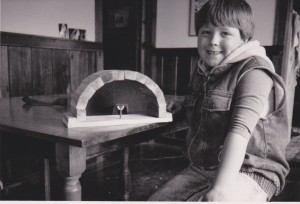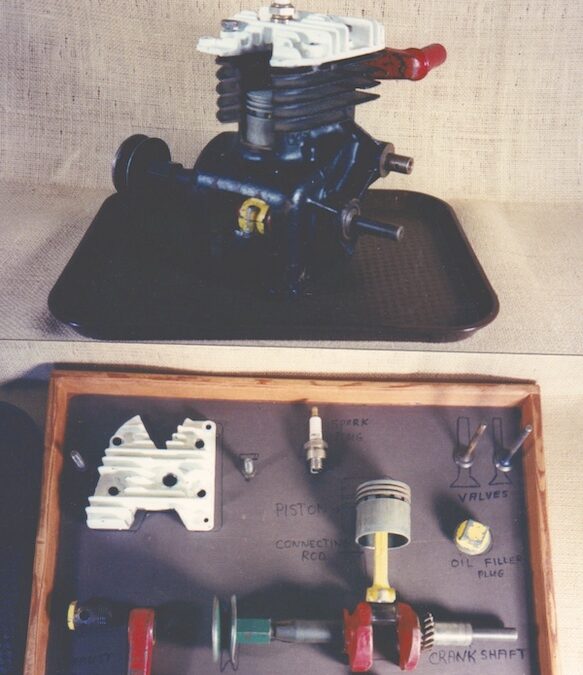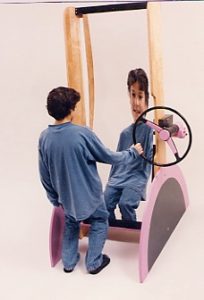 “This is Better than Recess”
“This is Better than Recess”
Back in the day one of my sons was not doing so well in school, I wanted to see what school was like for him, and see if there was anything I could do to help so I volunteered at his school. Although I didn’t realize it at the time, I wasn’t doing great then either. I was tired of working alone and was becoming jaded about building. At first I just took 3 or 4 kids to the lunch room and took apart old radios, tape decks and record players. Like my kids, kids at school liked to take things apart. For some it was a relief to get out of the classroom. When one child said, “This is better than recess,” I wondered if I might be on to something. Working with kids made me feel good. They were so curious, and interested, and never judgmental. I found if I held back trying to “teach” anything and concentrated on finding interesting (and fun) things for them to do surprising things would happen. Kids led the way.
One day, during take-apart a third grader said, “We want to make something that really works. It was a good idea. We had been saving the “good stuff,” lights, motors, and switches for a while so had plenty of parts, but the kids were ready to move on. I had some parts at home too. But what to make? The kid’s ideas were either non existent, impractical, or off in the clouds, like a “working robot” which they were not ready for. Neither was I, for that matter.
However, I’d had an idea for a Rube Goldberg machine. I took the parts we had collected home, and attached them to old treadle sewing machine and made a device I hoped would appeal to kids. It had a zoetrope, a color wheel, a bronze slug crawling across the table, a worm gear, a flag waiver (bobbin winder), a bike generator hooked to a light, a tiny merry-go-round, a saw that actually cut wood (slowly), a revolution counter and an odd flipper device. Everything would move when the kids treadled. It could be added too later if we found any new possibilities. I took it apart and took the parts back to school and had the kids put it back together with me telling them how to use the tools and what to put where.
The machine I liked best was the one that made the slug move, and the movie go, and the color thing [wheel] spin. Sabrina 
The kids were pretty excited and the machine was a hit. No one was more surprised than I. Interestingly, I found my directions or explanations on how to do the treadle action didn’t help much. For that activity it was better for me to leave them alone and help each other. The machine was obviously made from junk, so the kids didn’t worry if something broke. If a belt slipped off, or the light didn’t work, I told them “No problem, let’s fix it.” And then proceeded to troubleshoot, by thinking out loud….”see how this belt is no longer connecting the pulleys? If we carefully put the belt in the big pully and start it part way into the little pulley then slowly roll the big pully by hand and the belt will pop back in”. The kids understood and started doing it too. A friend gave me a book with crazy Rube Goldberg drawings which helped kids visualize other devices and changes we might consider, most of them a little far out, but valuable to look at and think about. This Rube Goldberg book taught me how important humor was as a way to connect with kids.
Not long after the Rube Goldberg machine, the teacher talked me into presenting a science experiment to the class. After I finished a little girl handed me her write up of the experiment and asked, “Is this right?” She had written my explanation nearly word for word, looking for the “right answer,” but didn’t really understand the experiment. That and other experiences during the next couple months as a volunteer taught me kids needed more stuff to mess around with, to play, and experiment with out pressure of time, test and the “right answer.”
I’ve always been a person motivated by interest. If I was interested in something I would spend hours and hours learning about it, to the neglect of homework, I must say. Schools didn’t seem to be capitalizing on motivation. I couldn’t believe they were trying to teach electricity yet there was not one magnet in the class room. Magnets may be hidden in the curriculum somewhere but weren’t in the classroom. Magnets are a magic motivator (and for kids, (to me too) so I brought all sorts of magnets. I combed the old science books looking for things that would interest childre. I made a table and chair puzzle and a yahoo stick (sort of magic) from Dick Schnacke’s book American Folk Toys.
 At first kids often don’t see the block as a puzzle, but after I take it apart for them they want to put it together.
At first kids often don’t see the block as a puzzle, but after I take it apart for them they want to put it together.

Rub the stick against the notches (in a certain way) and the propeller will turn. Rub in another way (and shout Yahoo, yahoo) and the propeller turns a the opposite way.
Below is an arch puzzle. I got this idea from a children’s museum. Nobody seemed to be using the museum puzzle because there were almost 100 pieces which made it too complicated. I made the one below and kids loved it.
 Later I found the arch below in a Montessori catalog. Younger kids had a hard time until I attached the numbers.
Later I found the arch below in a Montessori catalog. Younger kids had a hard time until I attached the numbers. 
The marble roll was always a big hit. I copied an idea for a simple, yet clever, marble roll from a children’s museum. I found some “magic” tricks and showed the kids how they worked. Kids loved doing “magic” or puzzles for other kids, and even more liked to show their parents. I turned a lawnmower engine, a door lock, and a faucet into puzzles. I got Martin Gardner’s book, Perplexing Puzzles and Tantalizing Teasers and left it for kids to peruse. I made a double periscope (my father had made me one) so a person could look through (actually around) her hand. I showed kids a camera obscura, made from a carpet tube, tracing paper and aluminum foil, so they could see people and trees upside down with a device they could make and I was surprised by its popularity. I made an electricity table kids could use to hook up circuits of lights, bells, and other low voltage devices in the same way I made the Rube Goldberg machine. The teacher was intrigued so we made a “science table” in the back of the room where kids could experiment or do puzzles before class or if they finished their work.
From this volunteer work I was asked to go to other classrooms and later to do after school classes. I got a job teaching “shop” to kindergarteners at a Montessori school and later a summer job teaching a science class and woodworking classes for the county parks. To my surprise no one asked for credentials. My only experience with kids came from taking care of my own kids, which, thinking about it, counted for a lot. At the time, I was about 40, and kids rekindled how amazing it is to use tools and build something useful, or clever, or beautiful and share it with others.
All this lead me to putting together a small pickup load of science, folk toy, puzzles and magic like things for kids to experiment with which I called The Science Circus. I took this to schools for 4 years in the spring in the mid 1990’s. It was my own mini science museum, coming to your school. Alas, by the end of the 90’s schools were teaching to the test more, PTA’s were on the decline, and it became too much unpaid work.
Looking back I wondered if spending a just two one hour sessions with kids had any effect. Here are quotes from some letters I received from kids so you can decide.
Letters from Kids and a teacher:
I can’t believe how common ordinary things make such neat wonderful projects. Anna
The T puzzle was challenging but I finally solved it. I couldn’t do the nail puzzle but it was still fun. I made a sundial and it really works! I have to say it was fun. More than fun. I just don’t know what to say. Troy
I always showed kids how to do the nail puzzle. The one above was built by a child in my kindergarten “shop” class. They loved taking it home as showing their parents how to do it.
I especially liked the sewing table that made the slug crawl across the table. Your inventions gave me ideas to give to my little sister for her science project. I also liked the hair dryer and ping pong ball and the vibrating speak Joni
I liked those things you made with junk. I liked the bendy mirror it made me short and fat and that was funny. Nathan liked it because it make him look big and thin. Keith
To Jack, a science manyock [maniac] and a real nice person. Tara
I really like the sieve that holds water. It was cool. I wish we could do more stuff like that. Tia
My favorite thing was the iron filings that move around with a magnet. How do you make all those science experiments? Christina
My favorite thing was the hovercraft and the telephone. It was the fun-est things our class did. Alan.
I made one of those things [camera obscura] that makes stuff look upside down. PS: All the experiments were very doubly, triplely, quadrupley fun.Angela
I liked how you are nice. I like how you carved the logs and me and Griffin and Colin and Loren had fun.Ashley
I liked the Likin logs. What are they made out of? Is it something we have at home? Jeff
I sure wanted that Lincoln Log set. Jonathan
My favorite thing was the ball roll. Anthony and me made a highway. My sister didn’t want to leave. Danny
My favorite machine was the do-nothing-machine and my second favorite was the hovercraft. Derek
I liked the mirror thing. How to you make all those things, with your hands? Cory
I liked the electric table a lot because I liked hooking up electric stuff. Reid
Popularity of the electric table surprised me. The first time I tried to tell a group of kids what it was and how it worked I got a lot of blank stares. But when I left it in back of the classroom I found one or two of the kids did actually understand and they were showing the others how to hook up lights, etc.
I made a sieve that holds water and a camera obscura. I had a lot of fun. Kipp
I really enjoyed the sewing machine contraption and the Lincoln Log house and the electricity table. Keri
I liked it when you told us how things worked. Jared
That lawn mower engine is neat because you can take it apart. Stephane
My favorite thing was the marble runway and the sewing machine contraption. The cross the river puzzle was difficult. I think the faucet was harder than the engine. Mike
After you had the Science Circus here science is fun for me. I discovered you have to really work to keep the ping pong ball in the air with the hair dryer. Christina
I liked the bike pump that ran the steam engine. Nicole
My dad said we could use some of his pipe to make a marble runway. I wish you could come again. Lonny
I did the telescope [camera obscura] when you look in it and people are walking upside down. It was real fun. Daniel
I made that whirlpool thing with the pop bottles and it worked perfect. Jeff
I liked the hot dog cooker and the vibrating machine and the sewing machine and the whirlpool bottles. I liked everything. Devin
Thank you for just being really nice and helpful. Jenny
I really liked the prism. Andy
How did you make the mirror steeror and the potato powered clock that was incredible? And the electricity table? I wanted to ask how the goat got across the river. The lawn mower was hard to put together. Steve
Kids were always amazed by the potato powered clock. A potato powered clock (without potatoes) below. 
I never knew you could have so much fun with science and learn so much. My favorite thing was the sewing machine. Cassandra
I made the ping pong ball stay in the air with the hair dryer. It was neat to see your face look so weird in the mirror. Elizabeth
I made the sieve that holds water and I made rope. I wish I had brought a pencil to make the magnet hovering thing. I am going to make a rope machine. Emma
You helped a lot of people with their questions, that is how it was fun. Kayla
I learned everything in science is not mechanical. Josiah
It was hard making the do-nothing-machine. The whirlpool bottles were neat. I liked the telephone. Nicholas
I liked the sieve that holds water and the sundial. Did you make all these things yourself? Jocelyn
Thanks for helping us make stuff. The puzzles were very fun. Matt
The lock puzzle. In the second picture I set it in a door frame.I removed the door knob for the picture to make the lock easier to see.

 The best thing about the door lock happened when a kid said, “I want to pick the lock.” I gave them a big paper clip and a pair of needle nose pliers and told them to try. And they succeeded. After that I always asked kids if they wanted to pick the lock and someone always did.
The best thing about the door lock happened when a kid said, “I want to pick the lock.” I gave them a big paper clip and a pair of needle nose pliers and told them to try. And they succeeded. After that I always asked kids if they wanted to pick the lock and someone always did.
Thanks for helping us build the periscope and the camera thingy. (camera obscura) Jerico
Your projects were the best I’ve ever seen. I did a lot of stuff over with the electricity. Barbie
I liked the solar cell and the do nothing machine. Your buzzer inspired me to make a smoke alarm for my science project. Shawn
I liked the solar hot dog cooker, the whirlpool maker and the neat puzzles. Donald
I liked the neat science stuff but my favorite one was the thing you have to have put in order from one to 31. Jacob
The number puzzle was always popular.
I liked it when we got to keep projects for our class. Today we don’t get recess so I will look at the things we made. Melissa
I learned how a transformer works. Sid
The crossing the river puzzle was hard, but I figured it out. Allison
And from a third grade teacher:
Wow! I can’t believe how you transformed the usually quiet library into an amazing “invention convention.” Some of the fascinating puzzles you brought completely baffled me! Trying to figure out how the mirror only reversed the letters in black was especially puzzling. When I finally did, I was surprised to discover how simple the solution was! All of the students in our class were impressed and full of wonder at all the machines and puzzles you brought in for us to experiment with. They were full of questions and extremely excited at their discoveries and at their opportunity to explore. Thank you so much!!
As a wrap up after the second hour I asked the kids, “Where do you think all these things came from? Many kids thought I invented them. I told them no, they came from the library. I combed the library for science books picking out things I thought would interest kids and then I went home and made them. I copied what a lot of people had done before me.
The Science Circus and later woodworking with kids was the most interesting, fun, and meaningful work I’ve ever done.













My son needed to talk about an Australian object beginning with P and didn’t want to do the usual platypus, parrot etc. I had a Pope smoother hand plane and he talked about that while I did some basic demonstrations. The kids were engaged, as were the teachers and wanted a shaving each and a cut off bit of wood ( I threw in a saw and some other basic tools) . They were so keen I had to make sure fingers weren’t put in the wrong places. The ability to engage with the seemingly mundane (to many people)and make it interesting is rewarding and can be one of the most positive things we can do.
Yes! And thank you.